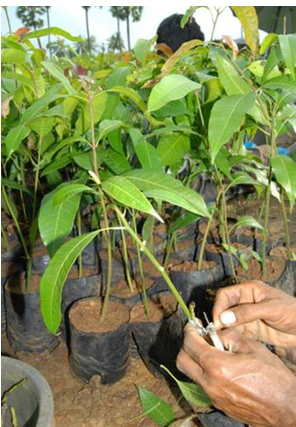| Inarching |
- The method of inarching or approach grafting is quite cumbersome and time consuming, but it is still the leading method for commercial propagation of mango plants
- The method consists of uniting the selected shoot (scion) of a desired parent tree (mother plant) with the potted or transplanted seedling (rootstock) by approach grafting.
- For this purpose, about one-year-old seedlings are most suitable when they attain a height of about 30-45 cm and thickness ranging from 0.75 to 1.5 cm.
- These seedlings are either grown in pots or under the mother plant from which the grafts are to be prepared.
- Generally, one-year-old twigs of the scion tree about 60 cm in length and nearly of the same thickness as that of the stock is chosen for grafting.
- Young and non-bearing trees should not be selected as mother plants.
- A thin slice of bark and wood, about 5 cm in length, 7.5 mm width and 2 mm deep, is removed by means of a sharp grafting knife from the stem of the stock as well as from the scion branch.
|
 |
- The cuts thus made should be absolutely flat, clean, boat shaped, even and smooth.
|
Inarching of mango
|
- The cut surfaces of both, i.e., stock and scion are made to coincide facing each other so that there remains no hollow space between the two.
- Polythene/alkathene strips of about 1.5 cm in width are tied around the union.
- After about one month of operation, the scion below the graft union and stock above the graft union should be given light "V" shape cuts at weekly interval in such a way that the grafts can finally be detached while giving the fourth cut.
- In the last stage, the top of the stock above graft union should also be removed completely.
- Inarching should be done during the active growth period.
- The end of the monsoon in heavy rainfall areas and early monsoons in the light rainfall areas is the best period for inarching
|
|

